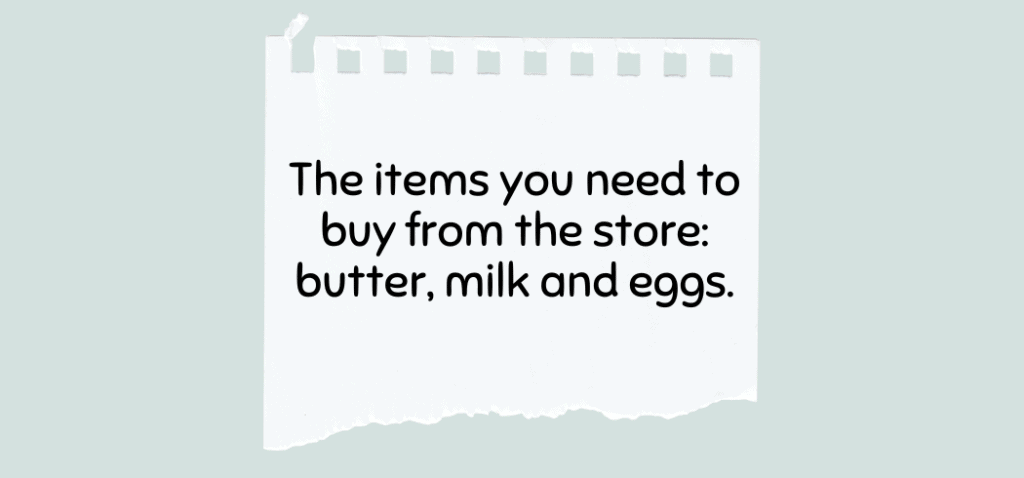Are you tired of feeling overwhelmed by all the rules of punctuation and dealing with punctuation errors?
You aren’t alone. Collectively there are dozens of punctuation rules and knowing them all feels like an impossible task.
However, chances are you already apply them without knowing since so many apply a common sense approach. Instead of focusing on the many rules you should know, why not focus on the common punctuation mistakes most people make in order to avoid them?
I’ve listed 21 common punctuation mistake examples and their corrections below so you can better recognize when you might make them in order to avoid them in the future.
Bad Punctuation Examples and How to Avoid Them
Everyone gets their grammar and conventions wrong from time to time, but there are some basic errors that even the most adapted writer gets mixed up with from time to time. Recognizing these mistakes can be difficult without going back through the many rules it relates to, and that can be a time-consuming effort.
The following examples highlight mistakes that trip up writers of all levels and can help you more quickly recognize when you might have gotten your punctuation all wrong.
21 Common Punctuation Errors People Make

Punctuation is an important part of your writing, and when used incorrectly can create confusion for your readers. Taking the time to understand where to place the correct punctuation marks helps create clarity and understanding for your reader.
Misplaced Apostrophes
DO NOT use apostrophes to make words plural.
DO use apostrophes to show possession and create contractions.
For example:
- INCORRECT: We are going to look at new home’s to purchase.
- Correct: We aren’t going over to Sarah’s house.
It’s vs. Its
Despite the above-mentioned rules of apostrophes, DO NOT use an apostrophe with the word it to show possession.
DO use an apostrophe to create a contraction (it is = it’s)
For example:
- This milk is past its expiration date.
Unnecessary Quotation Marks
DO NOT use single or double quotation marks on anything but what they are designated for.
Double quotation marks are used to indicate the direct speech and dialog or text from another source. They also are used to indicate titles and occasionally the slang use of a word in writing.
For example:
- The professor was direct in her speech, stating, “The expectations of this course are clear. You must attend every class if you expect to pass.”
- Have you read Dawson’s “The Power of Your Strength”? It is a quick read.
Single quotation marks are used to indicate a quote within a quote.
For example:
- Sarah looked at Mike and said, “I’m not sure what the confusion is. He made it clear when he stated, ‘Be at the park by 9 pm.’”
Wrong End Marks Placement with Quotations
The use of quotations can be used to enclose either part of or all of a complete sentence. If the sentence being quoted ends in an exclamation mark or question mark, they belong inside the quotation. Otherwise, they belong outside the last quotation mark.
For example:
- My boss was confused and asked, “Are you sure you closed the back door last night?”
Incorrect Parentheses Use
Parentheses are used to offset unnecessary information from a complete sentence or between two complete sentences. But, they are often overused or used incorrectly. DO use them in the correct manner and avoid using them more than once on a page.
For example:
- I headed to class (located all the way across campus) to ask the instructor if I could take the exam early.
Missing Commas
Commas have many rules associated with them, and it is important to include them where they belong. Without their use, your sentences may be choppy or difficult to understand.
Use them in the following manner:
- To join two independent clauses with a coordinating conjunction.
For example:
I am going to the pumpkin patch this weekend, and I plan on picking apples too.
- In dates and addresses.
For example:
The event begins in Plains, TX on September 22, 2023.
- After introductory words, phrases, and clauses
For example:
Once she met with the professor, explaining the directions to her team was easy.
- To offset nonessential information.
For example:
He thought the teacher, who was only 24 years old, was a great addition to the classroom.
- To separate items in a series
For example:
Pick up the groceries from the store, the mail from the PO box, and then the kids from school.
Too Many Commas
It’s more likely to use too many commas than not enough. Placing commas where they don’t belong is a common mistake, and you need to use the rules listed above to help you avoid their misuse.
Misplaced Periods
Misusing periods can lead to fragments or run-on sentences: two issues that create confusion for your reader. Be sure to place a period after the end of a complete sentence.
For example:
- INCORRECT RUN-ON: It wasn’t hard to pass the class all she had to do was show up on time the professor was more than fair about noticing the effort she put into her work.
- INCORRECT FRAGMENTS: The class wasn’t hard to show up. The professor was fair to notice. All her effort.
- CORRECT: It wasn’t hard to pass the class. All she had to do was show up on time. The professor was fair and noticed the effort she put into her work.
Comma Splicing
Comma splices are created when a comma is used when a period, semicolon, or colon should be used.
For example:
- INCORRECT: She said to come to the park, she said to wait here.
- CORRECT: She said to come to the park. She said to wait here.
- CORRECT: She said to come to the park; she said to wait here.
The rules pertaining to semicolons and colons are explained in #10 and #11, respectively.
Using Semicolons as Commas
Semicolons are used in place of a period to separate two independent clauses to indicate their relation to one another. They do not require the use of a coordinating conjunction.
For example:
- INCORRECT: She was heading to the store; and she needed to buy milk
- CORRECT: She was heading to the store, and she needed to buy milk.
- CORRECT: She was heading to the store; she needed to buy milk.
Semicolons are also used to separate complex items in a list that already have commas in them.
For example:
- We traveled cross country on vacation, stopping in Walter, Texas for dinner; Oak Dale, Oklahoma to sleep; and Fort Smith, Arkansas for breakfast the next day.
Using Colons as Semicolons
Colons are used after an independent clause to introduce a dependent clause or list of items. They do not indicate a relationship between two complete sentences.
For example:
- INCORRECT: The woods were dark that night: he could barely see the light from the house through the trees.
- CORRECT: The woods were dark that night; he could barely see the light from the house through the trees.
- CORRECT: The woods were dark that night: lights couldn’t be seen.
Colons After Fragments

Colons can only be used after an independent clause, not a fragment.
For example:
- INCORRECT: Pick up from the store: butter, milk, and eggs.
- CORRECT: There were only a few items left to pick up from the store: butter, milk, and eggs.
Two Spaces After a Period
Word processors, typewriters, and early computer word processing programs required you to place two spaces after a period to create consistent formatting and easy reading. Today, modern word processing doesn’t require this extra step. One space after a period is fine.
For example:
INCORRECT: Tomorrow is Monday. That means I have an early morning meeting.
CORRECT: Tomorrow is Monday. That means I have an early morning meeting.
Too Many Dashes
The Em-Dash works similarly to a comma or parentheses to offset unnecessary information from a complete sentence. It can also be used similar to a comma, colon, or semicolon to add information to a sentence. A dash should be used rarely and no more than once per page.
For example:
- INCORRECT: It wasn’t hard to reflect on life — things were hard enough as it was. She looked up to the mirror — wondering about where he was. Things had gone wrong long before she showed up — she just wished she hadn’t.
- CORRECT: It wasn’t hard to reflect on life; things were hard enough as it was. She looked up at the mirror, wondering where he was. Things had gone wrong long before she showed up — she just wished she hadn’t.
Using a Hyphen as a Dash
Hyphens are used to hyphenate words, not to be used as a substitute for a dash in a sentence.
For example:
- Merry-go-round
- Check-in
- Mother-in-law
Overuse of Exclamation Marks
It’s one thing to message a friend and use multiple exclamation marks to show excitement. However, using more than one exclamation mark after a sentence or multiple exclamation marks in each sentence should not be done.
For example:
- INCORRECT: I’m so excited for this weekend!!!
- INCORRECT: We had so much fun this weekend! We really need to do it again! I can’t wait!
- CORRECT: We had so much fun this weekend, and we really need to do it again. I can’t wait!
Not Capitalizing Titles
Titles should always be capitalized in order to indicate their importance and make them stand out against the rest of your text. Words such as a, the, an, of, or, etc. should not be capitalized as part of a title unless it is the first word of the title.
For example:
- INCORRECT: Fear the walking dead
- CORRECT: Fear the Walking Dead
Overuse of Capitalizations
Do not capitalize words that do not follow the general rules of capitalization, namely 1) The start of every sentence, 2) proper nouns, and 3) the word I.
For example:
- INCORRECT: We were Heading to California on our Road Trip, and when we stopped for Dinner, we realized we had a Flat Tire.
- CORRECT: We were heading to California on our road trip, and when we stopped for dinner, we realized we had a flat tire.
Avoiding Coordinating Conjunctions
Avoid writing in fragments and overusing semicolons when you properly use coordinating conjunctions to form complex compound sentences.
For example:
- INCORRECT: We went to the beach. Played all day in the sun and sand. Had bonfires that evening.
- CORRECT: We went to the beach and played all day in the sun and sand before we had a bonfire that evening.
Misplaced End Marks
When using quotations make sure to place end marks where they belong. Periods and commas always belong inside quotation marks. Exclamation points and question marks only belong inside if they are part of what is contained within the quote.
For example:
- INCORRECT: Jon looked up at the mood and shrugged, “it doesn’t matter”, he glanced down at her, “I’ll be gone by this time tomorrow anyway”.
- CORRECT: Jon looked up at the mood and shrugged, “it doesn’t matter,” he glanced down at her, “I’ll be gone by this time tomorrow anyway.”
- INCORRECT: Are you sure he said he’d “be at the crossroads by noon?”
- CORRECT: Are you sure he said he’d “be at the crossroads by noon”?
Emoticons
Just don’t. Unless you are messaging a friend, avoid emoticon use.
Let’s Review
Punctuation mistakes are common, but short of memorizing all the punctuation rules, you most likely might not always catch your mistakes. Our list highlights common punctuation mistakes and offers a decent punctuation mistake guide complete with examples to help you recognize the problems you might have with your writing.
Review your skills with our worksheet below.